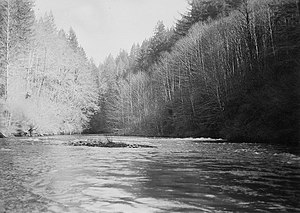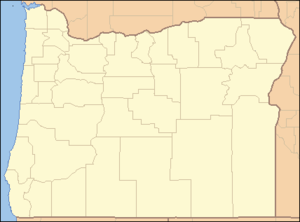Little Sandy River (Oregon)
| Little Sandy River | |
|
The Little Sandy River in March 1940
|
|
| Name origin: The Sandy River, which was called Quicksand River in 1805 by Lewis and Clark because of "emence quantitys of sand" at the mouth; apparently shortened to Sandy River locally by 1845–50 | |
| Country | United States |
|---|---|
| State | Oregon |
| County | Clackamas County |
| Source | Mount Hood National Forest |
| - location | Near Hickman Butte, west of Mount Hood, Clackamas County, Oregon |
| - elevation | 3,383 ft (1,031 m) |
| - coordinates | 45°24′13″N 121°55′58″W / 45.40361°N 121.93278°W |
| Mouth | Bull Run River |
| - location | near Bull Run, Clackamas County, Oregon |
| - elevation | 449 ft (137 m) |
| - coordinates | 45°25′34″N 122°12′24″W / 45.42611°N 122.20667°WCoordinates: 45°25′34″N 122°12′24″W / 45.42611°N 122.20667°W |
| Length | 15 mi (24 km) |
| Basin | 22.3 sq mi (58 km2) |
| Discharge | for 1.95 miles (3.14 km) from the mouth |
| - average | 143 cu ft/s (4 m3/s) |
| - max | 5,320 cu ft/s (151 m3/s) |
| - min | 8 cu ft/s (0 m3/s) |
|
Bull Run River watershed
|
|
The Little Sandy River is a tributary, roughly 15 miles (24 km) long, of the Bull Run River in the U.S. state of Oregon. Forming west of Mount Hood in the Mount Hood National Forest, it flows generally west, roughly parallel to the Sandy River to the south. Its entire course lies in Clackamas County, and most of its main stem and tributaries are within the Bull Run Watershed Management Unit (BRWMU), a restricted zone that protects Portland's main water supply.
In 2008, Portland General Electric (PGE) removed the Little Sandy Dam, the only dam on the river, while decommissioning its Bull Run Hydroelectric Project. This made possible, for the first time in nearly a century, the return of migratory salmon and steelhead to the river. In 2009, both types of fish were reported spawning above the former dam site.
Arising southeast of Hickman Butte in the Mount Hood National Forest, the river flows northwest between North Mountain on the and Goodfellow Lakes on the . Turning west, it passes south of Aschoff Buttes before receiving its only named tributaries, Bow Creek and Arrow Creek, both from the right. As the river nears a United States Geological Survey (USGS) stream gauge at river mile (RM) 1.95 or river kilometer (RK) 3.14, a ridge, the Devil's Backbone, separates the Little Sandy from the Sandy River to the south. Just below the stream gauge, the Little Sandy passes the former Little Sandy Dam. The river enters the Bull Run River about 2 miles (3.2 km) from the larger stream's confluence with the Sandy River. Falling 2,934 feet (894 m) between source and mouth, the river's average loss of elevation is about 196 feet per mile (37.1 m/km).
Most of the course of the river lies within the BRWMU, a federally protected area of 143 square miles (370 km2) surrounding the main drinking water supply for Portland. Access to the BRWMU is generally limited to government employees and guests on official business, and security guards keep watch on its three gated entrances. In 1996, the U.S. Congress banned commercial logging on all federal lands in the Bull Run River watershed and, through the Little Sandy Act of 2001, extended the ban to include all federal lands draining into the Little Sandy River and the lower Bull Run River.
...
Wikipedia



